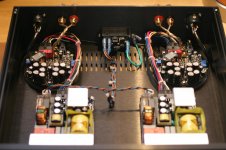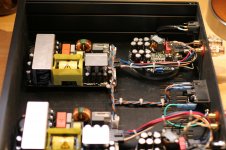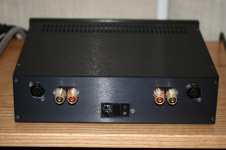I wonder the volume to blow a fuse.
I was a teenager!
since this thread has largely gone generic...As far as the contacts are not degraded, i think the contrary: As the impedance of the tinfoil is lower than the fuse's one, it is more linear with temperature.
But i wonder: klipschorns are pretty efficient, don't they ? I wonder the volume to blow a fuse.
I wonder... are these effects measurable (thermally-induced distortions)? I've heard the audiophile claims but I wonder if anyone attempted to measure something.
Last edited:
since this thread has largely gone generic...
I wonder... are these effects measurable (thermally-induced distortions)? I've heard the audiophile claims but I wonder if anyone attempted to measure something.
Hmm... While typical fuses have a surprisingly large resistance (around 0.1 ohm, depending on current rating), and that resistance is temperature-dependent, the temperature of the fuse would have to change significantly *during the time of one audio waveform* to cause a non-linear behaviour and thus distortion. I think the speakers have a much higher nonlinearity/distortion in themselves.
if I were to play the devil's advocate, I'd say that UCD already has distortion levels much below those of most speakers.Hmm... While typical fuses have a surprisingly large resistance (around 0.1 ohm, depending on current rating), and that resistance is temperature-dependent, the temperature of the fuse would have to change significantly *during the time of one audio waveform* to cause a non-linear behaviour and thus distortion. I think the speakers have a much higher nonlinearity/distortion in themselves.
I understand that it has to be a transitory phenomena not visible with steady sines (the typical subjectivist claim).
I don't know, really. it's an obvious selling point. I don't believe that it is audible just as I don't believe that -130 dB noise is audibly better than -110 dB. but who knows?
Some use Constantan wires in order to avoid the temperature behavior of traditional fuses.
Notice that, most of the time, fuses are on the amp board, and their distortion compensated by the feedback loop.
Loudspeaker side, you can have 3/4db of efficiency losses with temp. More than half the power, not a detail, and moving coils temperature is a major problem in PA systems or teenager's parties.
* Usually, teenagers are more in concern with pimples than distortion.
Notice that, most of the time, fuses are on the amp board, and their distortion compensated by the feedback loop.
Loudspeaker side, you can have 3/4db of efficiency losses with temp. More than half the power, not a detail, and moving coils temperature is a major problem in PA systems or teenager's parties.
* Usually, teenagers are more in concern with pimples than distortion.
Last edited:
interesting, I heard about Constantan (have no idea where) but didn't know anything about it.Some use Constantan wires in order to avoid the temperature behavior of traditional fuses.
Loudspeaker side, you can have 3/4db of efficiency losses with temp. More than half the power, not a detail, and a major problem of moving coils.
now the <replace with audiophile fuse price> dollars question: is that a very expensive alloy that requires very high tech equipment in order to be fitted inside a glass/ceramic tube with metal endings?
Are we talking about a regulated linear supply, or just the garden-variety, rectifier bridge plus large caps linear supply?
The regulation principle in a SMPS is, as the name implies, based on switching, whereas a linear regulator is based on a linear regulation component that works by adjusting a series resistance (that of course has to dissipate/waste a lot of power as heat).
So a SMPS is like a class D amp, while a linear regulator is just like a traditional, linear/analog amp.
I was referring to regulated linear supplies vs regulated SMPS supplies and the methods used for regulating the output.
It seems that my earlier quote from Bruno was taken to mean that you shouldn't use any regulated supply whereas he was only warning against regulated linear supplies and therefore linear regulation.
A regulated SMPS may behave very differently in that case and if AP2 has tried his regulated SMPS supply with ucd it should be fine with NC400.
Not at all. Just there is no (as far as i know) any calibrated fuse using -it. So, you have to calibrate your fuse yourself. You can sold-it directly on the board it-self, and just avoid to touch them when under power.is that a very expensive alloy that requires very high tech equipment in order to be fitted inside a glass/ceramic tube with metal endings?
I wonder why so few people take care of shielding their SMPS. They raditate EMI inside the box, and avoiding-them to reach the amp can have only positive effects.Almost finished here.
now the <replace with audiophile fuse price> dollars question: is that a very expensive alloy that requires very high tech equipment in order to be fitted inside a glass/ceramic tube with metal endings?
Constantan wire in small quantities is about $10 per meter, so the raw material for a fuse should cost about $0.1. No exotic or special equipment needed compared to normal wire fuses.
Only issues with constantan is a higher resistance than copper or silver, and a strong sensitivity to strain, so very theoretically it could cause microphonic effects.
the arrangement that Bruno used for demo/evaluation purposes has the SMPS very close to the amplifier board and it's unshielded. if it were that bad I'd guess that the evil effects of the SMPS would be visible in measurements.I wonder why so few people take care of shielding their SMPS. They raditate EMI inside the box, and avoiding-them to reach the amp can have only positive effects.
also, it looks like everyone forgets the fact that the amplifier itself is a switching device carrying amperes at hundreds of kHz's. the PCB traces that carry those signals are millimeters away from tens of SMD devices. at least on my UCD modules.
@Julf:
then the $70 each audiophile fuses must be justified by the measures taken to reduce microphony.
Last edited:
then the $70 each audiophile fuses must be justified by the measures taken to reduce microphony.
Aren't they intrinsically justified by the adjective "audiophile"?
I must be succeeding very well in hiding my sarcasm.Aren't they intrinsically justified by the adjective "audiophile"?
truth is that I'm curious how (if) those expensive fuses try to justify their prices. and let's say that since we're on diyaudio, we like to try to understand things, not just swallow whatever the hand wavers throw at us. otherwise we have the option of blindly ordering whatever component reaches the Stereophile recommended list.
I must be succeeding very well in hiding my sarcasm.
I apologize for emphasizing the sarcasm - I have found that sarcasm needs to be taken to slapstick levels to translate non-native-language and cultural boundaries.
let's say that since we're on diyaudio, we like to try to understand things, not just swallow whatever the hand wavers throw at us.
Some of us do. Others resort to cargo cult engineering (random tweaking, tube rolling etc.)
Are justified by their performance. If you do not believe it, try some at no risk yourself. Synergistic Research offers a money back guarantee on their fuses. Simple...
IME, actually using them, they offer performance gains well worth their price.
Looking at their web pages, I see a bunch of claims (" a noticeable increase in sound staging, resolution and air thanks to a lower noise floor and blacker backgrounds") but no explanation of what they think is causing the difference, apart from the "custom alloy treated with 2,000,000 volts of electricity!"
So what do you think causes the improved performance? And BTW, have you used double-blind ABX to compare them to regular fuses?
this is diyaudio, right?Are justified by their performance. If you do not believe it, try some at no risk yourself. Synergistic Research offers a money back guarantee on their fuses. Simple...
IME, actually using them, they offer performance gains well worth their price.
for many of us, at least part of being here is about having an interest on how things work. there are many subjective forums out there where no one is interested in how and why things work, good for them. I'm not aware about any explanation for the audiophile fuses and if it's only about that negative temperature coefficient material, it looks that they have the largest profit margin on the market. so I'm wondering if there's something else that can make a 2 cm piece of wire fitted on a tin socket improve the sound.
if we just succumb to the "just listen to it, it doesn't matter how it works" then there's no point for diyaudio to exist anymore.
excuse my bluntness, but you haven't been around much, haven't you? bringing DBT in any discussion of the kind is naive. it's like telling "let's just be civil" to the guy with a bat. "DBT can't possibly work" is the bat, you can't fight it, it's made of tough aluminumSo what do you think causes the improved performance? And BTW, have you used double-blind ABX to compare them to regular fuses?
Last edited:
for many of us, at least part of being here is about having an interest on how things work
+1
I grew up on stuff like "Wireless World" where the authors - leading designers of their time, such as Williamson, Linsley-Hood, Bailey and Radford - explained their designs and why they thought they were better than previous designs.
I am very happy that Bruno has followed in their footsteps, and shared his design ideas to an amazing detail. The nCore deserves more than just to be chucked into a box with random "audiophile" paraphernalia based on subjective praise. But, oh, well, it is just a hobby, and what works for me might not work for you...
- Status
- Not open for further replies.
- Home
- Amplifiers
- Class D
- Hypex Ncore


